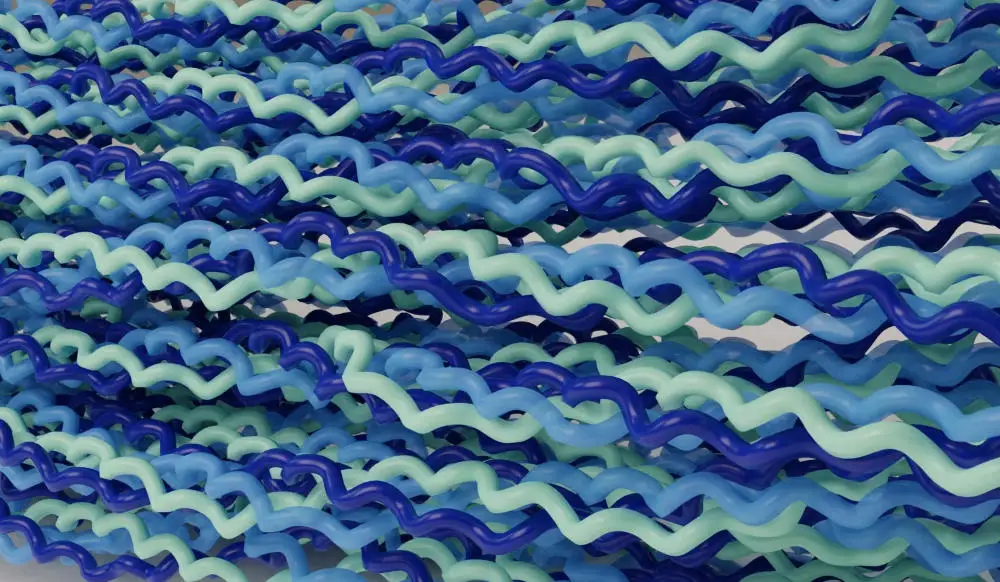Recent research has uncovered a fascinating aspect of collagen, the most abundant protein in our bodies. It appears that collagen possesses sacrificial bonds that break more readily than its basic structure when subjected to mechanical stress. These sacrificial bonds act as guardians, detecting and neutralizing harmful radicals that form during stress, thereby safeguarding the surrounding tissue.
The concept of sacrificing a part of itself to ensure longevity is not unique to collagen. Nature offers various examples, such as decoy burial chambers to thwart grave robbers, fuses that melt to protect electrical circuits, or lizards detaching their tails to facilitate escape.
The research, led by the Heidelberg Institute for Theoretical Studies (HITS) and published in Nature Communications, sheds light on collagen’s rupture mechanisms. By using computational and experimental techniques on rat tissue, the scientists discovered that weak bonds within the collagen’s crosslinks are more likely to break before other bonds in the collagen backbone. This sacrificial mechanism localizes damage and supports molecular recovery processes.
Collagen plays a vital role in our bodies, providing strength to bones, elasticity to skin, protection to organs, flexibility to tendons, aiding blood clotting, and supporting the growth of new cells. Structurally, collagen resembles a triple-braided helix, with amino acid chains intertwining to form a strong and rigid backbone.
The researchers found that mature collagen crosslinks have one weaker arm, which tends to rupture first under excessive force. This dissipation of force and the localized effects of ruptures help preserve the overall structural integrity of the collagen tissue.
Understanding these rupture sites in collagen could lead to valuable insights into tissue degradation, material aging, and potentially advance tissue engineering techniques. It could also aid in devising strategies to enhance collagen’s resilience and mitigate damage. The study was funded by the H2020 European Research Council and Klaus Tschira Stiftung.
Table of Contents
Frequently Asked Questions (FAQs) about resilience
What is the main focus of the research?
The main focus of the research is to understand how collagen’s sacrificial bonds protect tissues by breaking under stress, promoting resilience and aiding tissue engineering techniques.
What is collagen and its significance in our bodies?
Collagen is the most abundant protein in our bodies, comprising about 30% of all proteins. It provides strength to bones, elasticity to skin, protection to organs, flexibility to tendons, aids in blood clotting, and supports the growth of new cells.
How do sacrificial bonds in collagen work?
Sacrificial bonds in collagen are weaker than other bonds in the tissue. When subjected to excessive force, these weaker bonds break first, dissipating the force and localizing the effects of damage-causing radicals.
What insights does this research offer?
The research offers insights into tissue degradation, material aging, and potential advancements in tissue engineering techniques. Understanding collagen’s rupture mechanisms can help develop strategies to enhance its resilience and mitigate damage.
How was the research conducted?
The research used complementary computational and experimental techniques on rat tissue. Computer simulations of collagen were performed across different biological scales, and experiments were conducted on rat tails, flexors, and Achilles’ tendons.
What are the potential implications of this study?
The study’s findings could lead to a better understanding of tissue aging, promote the development of tissue engineering techniques, and potentially improve treatments for various medical conditions related to collagen resilience.
More about resilience
- Nature Communications: Collagen breaks at weak sacrificial bonds taming its mechanoradicals
- Heidelberg Institute for Theoretical Studies (HITS): Research Highlights
- European Research Council (ERC): H2020 Funding Program
- Klaus Tschira Stiftung: Funding Initiatives


